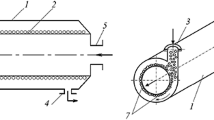Conclusions
A 30-minute exposure in a 2.45 megacycle, 3100-watt electronic oven was sufficient to kill all the ring rot bacteria in heavily contaminated jute strands placed throughout a bale of 100 bags. The maximum temperature reached within the bale was slightly over 270° F., at the center, but the bacteria were killed at a temperature of 230° F. at the outside. It has been shown experimentally that temperatures of over 300° F. and an exposure of 10 minutes are necessary to kill the organism (4). In the present trials, a temperature of 230° F. dropping to 169° F. over a 3-hour period killed all the ring rot bacteria. This inconsistency may be explained by the prolonged exposure to a lower temperature, or by the type of heating. High protein materials, such as bacteria, become heated more rapidly in electronic heating than do poor conductors such as jute strands. The temperature within the bale of bags would not, under the conditions of this experiment, truly represent the temperature to which the bacteria themselves were exposed. Although the relative humidity within the baled bags was not determined, water droplets collected on the sides of the oven during the treatment. The humidity during the treatments, may have, to some extent, influenced the rate at which the ring rot organism was killed. A recent publication by Richardson (5) indicates that high relative humidity has a marked effect on the susceptibility of the ring rot organism to heat treatment.
Similar content being viewed by others
Literature Cited
Anonymous. 1950. For germs: Electric chair instead of gas chamber. Electrified Industry, August, 1950. P. 17.
MacLachlan, D. S. and H. N. Racicot. 1950. Some methods of used bag disinfection in potato ring rot control. 32nd Ann. Rept. Que. Soc. Prot. P1. 57–63.
, H. A. U. Monro, H. N. Racicot and J. E. King. 1953. Fumigation of used bags with toxic gases for the control of bacterial ring rot of potato. Can. Jour. Agr. Sci. 33: 132–140.
Richardson, L. T. 1957. Quantitative determination of viability of potato ring rot bacteria following storage, heat, and gas treatments. Can. Jour. Botany. 35: 647–656.
, and C. T. Buckland. 1958. Eradication of ring rot bacteria from contaminated potato bags by moist heat treatment. P1. Dis. Reptr. 42: 241–245.
Additional information
Contribution No. 1696. from the Botany and Plant Pathology Division, Science Service, Canada Department of Agriculture, Ottawa, Ontario.
Rights and permissions
About this article
Cite this article
MacLachlan, D.S. Electronic heating as a means of sterilizing potato bags contaminated with bacterial ring rot. American Potato Journal 36, 52–55 (1959). https://doi.org/10.1007/BF02877281
Accepted:
Issue Date:
DOI: https://doi.org/10.1007/BF02877281




